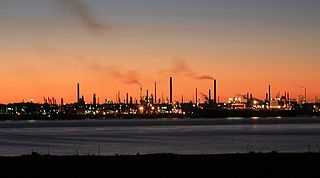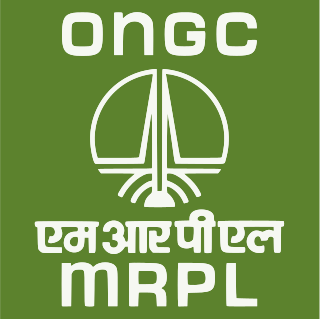
Guwahati Refinery was set up at Noonmati in Guwahati on 1 January 1962. Guwahati Refinery is the first Public Sector refinery of India and belongs to Indian Oil Corporation Limited. The refinery was inaugurated by Late Pandit Jawahar Lal Nehru, the first Prime Minister of independent India. The refinery was built with Romanian Collaboration and has a capacity of 1.0 million metric tonnes per annum. This refinery process crude oil from Upper Assam Oil Fields, India and helps cater energy need of the region. Major Products of this refinery are
- LPG,
- Motor Spirit (Petrol),
- Aviation Turbine Fuel (ATF),
- Kerosene,
- High Speed Diesel,
- Light Diesel Oil and
- Raw Petroleum Coke.

Barauni Refinery is an oil refinery located in Begusarai city in the state of Bihar, operated by Indian Oil Corporation (IOCL). It was the dream project of Shri Krishna Singh the first chief minister of Bihar. It was built in collaboration with the Soviet Union, with limited participation from Romania, at a cost of Rs. 49.4 crores and went on stream in July 1964. The initial capacity of 1 million tonnes per year was expanded to 3 million tonnes per year by 1969. The present capacity of this refinery is 6.100 million tonnes per year. Indian Oil Corporation has planned to expand its capacity from 6 million tonnes per year to 9 million tonnes per year at the cost of $1.94 billion.
The Gujarat Refinery is an oil refinery located at Koyali, Vadodara District in Gujarat, Western India. It is the third largest refinery owned by Indian Oil Corporation after Paradip and Panipat Refinery. The refinery is currently under projected expansion to 18 million tonnes per year.
The Mathura Refinery, owned by Indian Oil Corporation, is the sixth refinery of IndianOil located in Mathura, Uttar Pradesh, India. The refinery processes low sulphur crude from Bombay High, imported low sulphur crude from Nigeria, and high sulphur crude from the Middle East.

Visakhapatnam Refinery, is one of the two oil refineries of HPCL in India, the other being Mumbai Refinery. This was one of the first major industries of Visakhapatnam and first oil refinery on the East Coast. After the nationalisation, HPCL has transformed itself into a mega Public Sector Undertaking and it is second largest integrated oil company in India.

Chennai Petroleum Corporation Limited (CPCL), formerly known as Madras Refineries Limited (MRL), is a subsidiary of Indian Oil Corporation Limited which is under the ownership of Ministry of Petroleum and Natural Gas of the Government of India. It is headquartered in Chennai, India. It was formed as a joint venture in 1965 between the Government of India (GOI), Amoco and National Iranian Oil Company (NIOC), having a shareholding in the ratio 74%: 13%: 13% respectively. From the grassroots stage CPCL Refinery was set up with an installed capacity of 2.5 million tonnes per year in a record time of 27 months at a cost of ₹430 million (US$5.2 million) without any time or cost overrun.
The Vadinar refinery is an oil refinery at Vadinar, Gujarat, India. It is owned and operated by Nayara Energy Limited, in which Rosneft owns a 49.13% stake. The refinery is India's second largest single-location refinery, with an annual capacity of 20 million tonnes and a complexity of 11.8, which also makes it among the world's most complex refineries.

Kochi Refinery Limited (KRL) is a crude oil refinery in the city of Kochi in Kerala, India. It is the largest public sector refinery in India with a production capacity of 15.5 million tonnes per year. Formerly known as Cochin Refineries Limited and later renamed as Kochi Refineries Limited, it was acquired by Bharat Petroleum Corporation Limited in the year 2006. The refinery is situated at Ambalamugal, around 12 km (7.5 mi) east of the city centre.

GAIL (India) Limited is an Indian state-owned energy corporation with primary interests in the trade, transmission and production distribution of natural gas. GAIL also has interests in the exploration and production solar and wind power, telecom and telemetry services (GAILTEL) and electricity generation. GAIL was founded as the Gas Authority of India Ltd. in August 1984 under the Ministry of Petroleum and Natural Gas to build, operate and maintain the HVJ Gas Pipeline. On 1 February 2013, the Indian government conferred GAIL with Maharatna status along with 11 other Public Sector Undertakings (PSUs).
Ras Lanuf Oil and Gas Processing Company (Rasco) is a subsidiary of the state-owned National Oil Corporation of Libya. Rasco operates the Ras Lanuf Refinery.

Fawley Refinery is an oil refinery located at Fawley, Hampshire, England. The refinery is owned by Esso Petroleum Company Limited, a subsidiary of Exxon Mobil Corporation, which acquired the site in 1925. Situated on Southampton Water, it was rebuilt and extended in 1951 and is now the largest oil refinery in the United Kingdom, and one of the most complex refineries in Europe. With a capacity of 270,000 barrels (43,000 m3) per day, Fawley provides 20 per cent of the UK's refinery capacity. Over 2,500 people are employed at the site.
The Płock refinery is a large oil refinery and petrochemical complex located in Płock, Poland. It is owned by PKN Orlen, and is one of the two crude oil refineries in Poland, the other one is Gdansk refinery. The refinery has a Nelson complexity index of 9.5 and a capacity is 16.3 million tonnes per year or 276,000 barrels per day of crude oil.

Gdańsk oil refinery is a 10.5 million tonne per year refinery located near the Polish city of Gdańsk on the Baltic Sea. The refinery was established in 1975 to supply fuels and lubricants, and has undergone several upgrades and expansions to increase its capacity and the range of products available. It now has a Nelson complexity index of 11.1. It is one of two oil refineries in Poland, the other is Plock refinery.

The BPRefinery (Kent) was an oil refinery on the Isle of Grain in Kent. It was commissioned in 1953 and had a maximum processing capacity of 11 million tonnes of crude oil per year. It was decommissioned in August 1982.

Mangalore Refinery and Petrochemicals Limited (MRPL), is a division of Oil and Natural Gas Corporation (ONGC) which is under the ownership of the Ministry of Petroleum and Natural Gas of the Government of India. Established in 1988, the refinery is located at Katipalla, north from the centre of Mangalore. The refinery was established after displacing five villages, namely, Bala, Kalavar, Kuthetoor, Katipalla, and Adyapadi.

Krishna Godavari Basin is a peri-cratonic passive margin basin in India. It is spread across more than 50,000 square kilometres in the Krishna River and Godavari River basins in Andhra Pradesh. The site is known for the D-6 block where Reliance Industries discovered the biggest natural gas reserves in India in 2003.
Paradip Refinery is an oil refinery set up by Indian Oil Corporation in Paradip town in the state of Odisha. It was commissioned in 2016 with an installed capacity of 15 million tonnes per year. This refinery is spread over approximately 3,345 acres of land and is situated approximately 5 km southwest from the Paradip Port.
Bharat Oman Refineries Limited (BORL) which is under the ownership of Ministry of Petroleum and Natural Gas of the government of India. It owns and operates Bina Refinery, located at Bina in the Sagar of the state of Madhya Pradesh in India. The company was incorporated as a joint venture between Bharat Petroleum Corporation (BPCL) and Oman Oil Company Ltd. Since 2021, it is a wholly owned subsidiary of BPCL. The Bina Refinery was commissioned in 11 May 2011 with an annual capacity of 6 million tonnes. The capacity of the refinery was further enhanced to 7.8 million tonnes per year in 2018.

Indian Oil Corporation Limited, trading as IndianOil, is an Indian multinational oil and gas company under the ownership of Government of India and administrative control of the Ministry of Petroleum and Natural Gas. It is a public sector undertaking which is registered in Mumbai but headquartered in New Delhi. It is the largest government-owned oil producer in the country both in terms of capacity and revenue. It has consolidated refining capacity of 80.55MMTPA.
Barmer Refinery is an upcoming public sector refinery and petrochemical complex in the Pachpadra of Rajasthan, India. It is owned by HPCL Rajasthan Refinery Limited (HRRL), a joint venture between Hindustan Petroleum Corporation Limited and the Government of Rajasthan. This refinery will be connected with Jamnagar Refinery and Bathinda Refinery through Amritsar Jamnagar Expressway.











